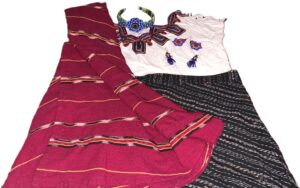By S. Job, Los Angeles Unified School District Student, Class of 2024
Content Warning: This blog discusses potentially triggering information regarding the experiences of Native students at Indian boarding schools under the section “Historical Significance of Wearing Tribal Regalia.”
Last year, I wrote a blog for My School, My Rights titled “Preserving Our Cultural Rights at Graduation.” I was in my junior year of high school taking a prospective look towards my high school graduation hoping to wear clothing patterns and regalia that represents my indigenous K’iche’ ancestry as I walk up stage.

Now, I am excited to write as a high school senior, only two weeks away from graduating, as I wait for my aunt to finish sewing fabrics that belonged to my late grandmother into a graduation stole and a huipil (traditional Mayan K’iche’ skirt) for me to wear during my graduation ceremony. As I reflect back on the visions I had for graduation, I am met with relief— my worry that my culture would be stripped from me during this educational milestone has dissipated because I know that I have the right as a student in California to wear tribal regalia and/or cultural and/or religious adornments at graduation.
As a graduating Indigenous student, the purpose of this blog reflects the urgency of protecting the right to wear tribal regalia at graduation, educating other Indigenous students on their right to embrace their culture, and the overall significance it has on Indigenous students to be allowed to express their culture as a means of preserving our Indigenous identity after generations of cultural suppression, forced assimilation, and cultural genocide.
Historical Significance of Wearing Tribal Regalia
There has been an overbearingly long history of Native American and Indigenous culture being suppressed in the United States, through a project of cultural genocide, with the ultimate goal of assimilating generations of Indigenous youth. Cultural genocide and forced assimilation takes place through multiple institutions from the past and present, such as the Economy (which forces Indigenous people to leave their traditional economic customs and Indigenous people experience the highest poverty rate in America, 25.4%, despite making up 2.9% of the US population), Society (shunning non-normative cultural practices and the pervasive appropriation and misrepresentation of Indigenous cultures in media), Government (discrepancies in government aid and reparations, disregard for promises made in treaties, denial of the generational trauma that Indigenous groups experience, the co-option of Indigenous movements and beliefs in political contexts, and policies that forbade Native Americans from speaking their native languages and continue to prevent access to sacred land)— and especially in our Education.
Boarding schools serve as an example of how the education system inherently targets and aims to forcibly assimilate Indigenous youth under the guise of education. By 1925, nearly 60,000 — 83% of Native American children in total— were forcibly taken from their families and sent to “Indian” boarding schools, where such children would face atrocities, violence, and discrimination daily. Native children were met with violations of their traditional practices and ancestry, such as: the renaming of children to more “American names”, being physically stripped of any tribal clothing, prohibiting traditional hairstyles and cutting hair without consent of the families, forcing children to bathe in kerosene, banning them from speaking Native languages, subjecting them to physical abuse when rules were broken, and often beating children to death and burying them in unmarked graves, without alerting families of such deaths. This prevented families from giving proper burial and practices to their children.
School System and Indigenous Expression
Despite many Indian boarding schools shutting down as a result of the Wheeler-Howard Indian Reorganization Act (1934) and various more being closed by 2007, the idea that Indigenous students should hide their culture in educational spaces is still rampant among our school systems. In fact, only 14 states out of the 50 in the US have enumerated the rights of indigenous students to wear tribal regalia at graduation: Alaska, Arizona, California, Kansas, Mississippi, Montana, Nebraska, Nevada, North Dakota, Oklahoma, Oregon, South Dakota, Utah, and Washington. Although the protection of tribal regalia in schools is one big step from the legacy of cultural shame among Native Americans, the access to such rights are still unclear to Indigenous students. Many schools, despite it being illegal, still try to restrict Indigenous students from wearing cultural regalia at graduation ceremonies; whether the school tries to blame it on a strict dress code or threatening to take away graduation privileges from Indigenous students if they try to do so. Today, Indigenous students still face the struggle of being able to express themselves freely without being restricted or threatened by the school system.
A simple way to combat this issue is to raise awareness to Indigenous students about the rights that they hold within their schools. By understanding the history behind stripping culture away from students in school, the importance of being able to express our culture freely, and educating Indigenous students about how to appropriately respond when their right to wear regalia is being violated, we can further support our Indigenous youth and preserve our culture despite attempts in history to erase it.
With this, I encourage students, families, educators, and our academic institutions to teach and share the rights that students are entitled to as graduation season begins. For more information on Tribal Regalia Rights for Graduation in California, please read the California Education Code section 35183.1 and visit the ACLU and California Indian Legal Services’ Tribal Regalia Toolkit.
If you or a classmate are experiencing a violation of your rights to wear tribal regalia at graduation in a California high school, please contact the ACLU of Southern California and ACLU of Northern California via email at [email protected] and refer to the Student Rights to Tribal, Cultural, and Religious Objects at Graduation Q&A guide to learn how you are able to defend your rights.
If you would like to contact the ACLU affiliates in California, please email [email protected]
